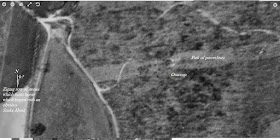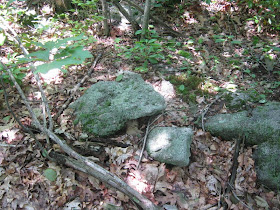The first local Southern Connecticut Giant that comes to my mind is Hobomock, the Sleeping Giant. I see him around from time to time:

"According to Native Americans of the Quinnipiac Tribe, the giant stone spirit Hobbomock (or Hobomock), a prominent wicked figure in many stories (see Pocumtuck Ridge and Quinnipiac), became enraged about the mistreatment of his people and stamped his foot down in anger, diverting the course of the Connecticut River (where the river suddenly swings east in Middletown, Connecticut after several hundred miles of running due south). To prevent him from wreaking such havoc in the future, the good spirit Keitan cast a spell on Hobbomock to sleep forever as the prominent man-like form of the Sleeping Giant ( Sleeping Giant Park Association.)
http://en.wikipedia.org/wiki/Sleeping_Giant_(Connecticut)
http://cptv2.org/nationalparks/content/keitan-hobbomocks-struggle
(Wiki described the Quinnipiac as Algonquian Speakers, adding on a link that: "The Algonquian Language Phyla was the largest in North America and covered about one-third of the continent above Mexico.")
And then there's this, a better description of why the giant was angry and then Sleepy:
"Often ancient oral legends have a factual basis. The tale of the giant beaver and the great lake is an interesting example of such fact and fable.
At the end of the last ice age, 15,000 - 12,000 years ago, a large lake covered the Connecticut River Valley (Lake Hitchcock). Also during the last ice age, a giant beaver species, Castoroides ohioensis, lived in the lakes and waterways at the glacier's margin. Based upon fossil evidence, this beaver was the size of a black bear (600 - 700 lbs). In contrast, the present-day North American beaver, Castor canadensis, occasionally attains a weight of 66 lbs. The giant beaver had enormous, convex incisor teeth, extending four inches (100 mm) beyond the gum line. Perhaps this giant rodent was the inspiration for the legends below."
The Giant Beaver (Pressey, 1910)
"The great beaver preyed upon the fish of the Long River. And when other food became scarce, he took to eating men out of the river villages. Hobomuck, a benevolent spirit giant, at last was invoked to relieve the distressed people. Hobomock came and chased the great beaver far into the immense lake that then covered the meadows, flinging as ran great handfuls of dirt and rock at the beaver. Finally he threw a bunch of dirt so great upon the beaver's head that it sank him in the middle of the lake. Hobomock, arriving a few minutes later, dispatched the monster by a blow with his club on the back of the beaver's neck. And there he lies to this day. The upturned head covered with dirt is the sandstone cliff of Wequamps (Mt. Sugar Loaf), and the body is the northward range. The hollow between is where Hobomock's cudgel smote down his neck (http://www.bio.umass.edu/biology/conn.river/nalegend.html)."
Other Giants:
A mural by Stanley Murphy shows the giant Moshup catching a whale at Aquinnah:
Once Called Noepe
"Martha’s Vineyard, or Noepe, was formed by glacier retreat about 10,000 years ago. Noepe is the Wampanoag word for Martha’s Vineyard. It translates as “amid the waters,” a reference to the two distinct tidal currents offshore.
 Wampum from Martha’s Vineyard.
Wampum from Martha’s Vineyard.
According to the Wampanoags, MV was created by the giant Moshup, who taught them how to farm and fish and set their destiny. Tribal member, Adrieno Ignacio says, “Moshup sustained our tribe. We think he is still there.”
Moshup (also spelled Maushup, Maushop, and several other ways.) Moshup is a giant who is the culture hero of the Mohegan and Wampanoag tribes (sometimes referred to as a "transformer" by folklorists.) His name is pronounced moh-shup or maw-shup, and he has a wife named Squannit (also spelled Squant, Squaunt, or Squauanit.) Moshup shares some similarities with other Algonquian heroes such as the Wabanaki Glooskap.
Hobbomock (also spelled Hobbomok, Hobbamock, Hobbamocho, Abbomocho, Hobomock, Hobomoco, Hobbomocho, or other ways): The manito (spirit) of death. A destructive, often evil being usually in opposition to Kautantowit. After the introduction of Christianity, Narragansett people frequently identified Hobbomock with the Devil. He was also sometimes known as Chepi or Chipi.




























































